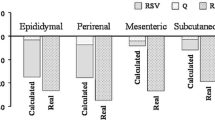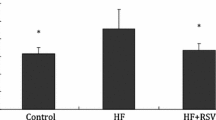Abstract
Scientific research is constantly looking for new molecules to be used as functional ingredients to combat obesity. The aim of the present study was to analyse whether resveratrol and conjugated linoleic acid (CLA) together could reduce body fat more efficiently than their separate administration. Thirty-six male Wistar rats were randomly divided into four groups: controls rats (C), rats treated with resveratrol (RSV), rats treated with CLA (CLA) and rats treated with a combination of resveratrol and CLA (RSV+CLA). All rats were fed on an obesogenic diet. In RSV and RSV+CLA groups, the rats received 30 mg resveratrol/kg body weight/day. In CLA and RSV+CLA groups, an equimolecular mixture of trans-10,cis-12 and cis-9,trans-11 was added to the diet to reach 0.5% of the active isomer trans-10,cis-12. After 6 weeks of treatment, white adipose tissue from different anatomical locations was dissected and weighed. Serum triacylglycerols, total and HDL cholesterols, glucose, insulin, fructosamine and TNF-α were measured. A glucose tolerance test was also performed. Separately, resveratrol and CLA significantly reduced body fat but did not do so when combined: 20% in the RSV group and 18% in CLA group but 7% in the RSV+CLA group. Resveratrol reduced serum triacylglycerols. No differences were found among groups in serum cholesterol. Resveratrol, as well as the combination RSV+CLA, improved glycaemic control. These results demonstrate that the combination RSV+CLA reduces the effectiveness of each compound on body fat-lowering action, but it maintains the positive effect of resveratrol on glycaemic control. Consequently, this combination has no usefulness in obesity prevention.




Similar content being viewed by others
References
Adams KF, Schatzkin A, Harris TB, Kipnis V, Mouw T, Ballard-Barbash R, Hollenbeck A, Leitzmann MF (2006) Overweight, obesity, and mortality in a large prospective cohort of persons 50 to 71 years old. N Engl J Med 355:763–778
Ahn J, Cho I, Kim S, Kwon D, Ha T (2008) Dietary resveratrol alters lipid metabolism-related gene expression of mice on an atherogenic diet. J Hepatol 49:1019–1028
Alcaín FJ, Villalba JM (2009) Sirtuin activators. Expert Opin Ther Pat 19:403–414
Bai L, Pang WJ, Yang YJ, Yang GS (2008) Modulation of Sirt1 by resveratrol and nicotinamide alters proliferation and differentiation of pig preadipocytes. Mol Cell Biochem 307:129–140
Baur JA, Pearson KJ, Price NL, Jamieson HA, Lerin C, Kalra A, Prabhu VV, Allard JS, Lopez-Lluch G, Lewis K, Pistell PJ, Poosala S, Becker KG, Boss O, Gwinn D, Wang M, Ramaswamy S, Fishbein KW, Spencer RG, Lakatta EG, Le Couteur D, Shaw RJ, Navas P, Puigserver P, Ingram DK, de Cabo R, Sinclair DA (2006) Resveratrol improves health and survival of mice on a high-calorie diet. Nature 444:337–342
Berg AH, Scherer PE (2005) Adipose tissue, inflammation, and cardiovascular disease. Circ Res 96:939–949
Bhattacharya A, Banu J, Rahman M, Causey J, Fernandes G (2006) Biological effects of conjugated linoleic acids in health and disease. J Nutr Biochem 17:789–810
Churruca I, Fernández-Quintela A, Portillo MP (2009) Conjugated linoleic acid isomers: differences in metabolism and biological effects. Biofactors 35:105–111
Howitz KT, Bitterman KJ, Cohen HY, Lamming DW, Lavu S, Wood JG, Zipkin RE, Chung P, Kisielewski A, Zhang LL, Scherer B, Sinclair DA (2003) Small molecule activators of sirtuins extend Saccharomyces cerevisiae lifespan. Nature 425:191–196
James PT, Rigby N, Leach R, International Obesity Task Force (2004) The obesity epidemic, metabolic syndrome and future prevention strategies. Eur J Cardiovasc Prev Rehabil 11:3–8
Kennedy A, Overman A, Lapoint K, Hopkins R, West T, Chuang CC, Martínez K, McIntosh M (2009) Conjugated linoleic acid-mediated inflammation and insulin resistance in human adipocytes are attenuated by resveratrol. J Lipid Res 50:225–232
Lagouge M, Argmann C, Gerhart-Hines Z, Meziane H, Lerin C, Daussin F, Messadeq N, Milne J, Lambert P, Elliott P, Geny B, Laakso M, Puigserver P, Auwerx J (2006) Resveratrol improves mitochondrial function and protects against metabolic disease by activating SIRT1 and PGC-1alpha. Cell 127:1109–1122
Larsen TM, Toubro S, Astrup A (2003) Efficacy and safety of dietary supplements containing CLA for the treatment of obesity: evidence from animal and human studies. J Lipid Res 44:2234–2241
Li JJ, Huang CJ, Xie D (2008) Anti-obesity effects of conjugated linoleic acid, docosahexaenoic acid, and eicosapentaenoic acid. Mol Nutr Food Res 52:631–645
Macarulla MT, Alberdi G, Gómez S, Tueros I, Bald C, Rodríguez VM, Martínez JA, Portillo MP (2009) Effects of different doses of resveratrol on body fat and serum parameters in rats fed a hypercaloric diet. J Physiol Biochem 65:369–376
Martin JC, Valeille K (2002) Conjugated linoleic acids: all the same or to everyone its own function? Reprod Nutr Dev 42:525–536
Matthews DR, Hosker JP, Rudenski AS, Naylor BA, Treacher DF, Turner RC (1985) Homeostasis model assessment: insulin resistance and beta-cell function from fasting plasma glucose and insulin concentrations in man. Diabetologia 28:412–419
Miranda J, Fernández-Quintela A, Macarulla MT, Churruca I, García C, Rodríguez VM, Simón E, Portillo MP (2009) A comparison between CLNA and CLA effects on body fat, serum parameters and liver composition. J Physiol Biochem 65:25–32
Navarro V, Zabala A, Macarulla MT, Fernández-Quintela A, Rodríguez VM, Simón E, Portillo MP (2003) Effects of conjugated linoleic acid on body fat accumulation and serum lipids in hamsters fed an atherogenic diet. J Physiol Biochem 59:193–199
Navarro V, Fernández-Quintela A, Churruca I, Portillo MP (2006) The body-fat lowering effect of conjugated linoleic acid: a comparison between animal and human studies. J Physiol Biochem 62:137–147
Palsamy P, Sivakumar S, Subramanian S (2010) Resveratrol attenuates hyperglycemia-mediated oxidative stress, proinflammatory cytokines and protects hepatocytes ultrastructure in streptozotocin–nicotinamide-induced experimental diabetic rats. Chem Biol Interact 186:200–210
Picard F, Kurtev M, Chung N, Topark-Ngarm A, Senawong T, Machado De Oliveira R, Leid M, McBurney MW, Guarente L (2004) Sirt1 promotes fat mobilization in white adipocytes by repressing PPAR-gamma. Nature 429:771–776
Poirier H, Niot I, Clément L, Guerre-Millo M, Besnard P (2005) Development of conjugated linoleic acid (CLA)-mediated lipoatrophic syndrome in the mouse. Biochimie 87:73–79
Rayalam S, Della-Fera MA, Yang JY, Park HJ, Ambati S, Baile CA (2007) Resveratrol potentiates genistein’s antiadipogenic and proapoptotic effects in 3T3-L1 adipocytes. J Nutr 137:2668–2673
Rivera L, Morón R, Zarzuelo A, Galisteo M (2009) Long-term resveratrol administration reduces metabolic disturbances and lowers blood pressure in obese Zucker rats. Biochem Pharmacol 77:1053–1063
Salas-Salvadó J, Márquez-Sandoval F, Bulló M (2006) Conjugated linoleic acid intake in humans: a systematic review focusing on its effect on body composition, glucose, and lipid metabolism. Crit Rev Food Sci Nutr 46:479–488
Sharma S, Misra CS, Arumugam S, Roy S, Shah V, Davis JA, Shirumalla RK, Ray A (2011) Antidiabetic activity of resveratrol, a known SIRT1 activator in a genetic model for type-2 diabetes. Phytother Res 25:67–73
Szkudelska K, Szkudelski T (2010) Resveratrol, obesity and diabetes. Eur J Pharmacol 635:1–8
Szkudelska K, Nogowski L, Szkudelski T (2009) Resveratrol, a naturally occurring diphenolic compound, affects lipogenesis, lipolysis and the antilipolytic action of insulin in isolated rat adipocytes. J Steroid Biochem Mol Biol 113:17–24
Szkudelski T (2008) The insulin-suppressive effect of resveratrol—an in vitro and in vivo phenomenon. Life Sci 82:430–435
Tai MM (1994) A mathematical model for the determination of total area under glucose tolerance and other metabolic curves. Diabetes Care 17:152–154
Tchernof A (2007) Visceral adipocytes and the metabolic syndrome. Nutr Rev 65:S24–S29
Tresaco B, Bueno G, Moreno LA, Garagorri JM, Bueno M (2003) Insulin resistance and impaired glucose tolerance in obese children and adolescents. J Physiol Biochem 59:217–223
Tricon S, Burdge GC, Willimas CM, Calder PC, Yaqoob P (2005) The effects of conjugated linoleic acid on human health-related outcomes. Proc Nutr Soc 64:171–182
Wang YW, Jones PJ (2004) Conjugated linoleic acid and obesity control: efficacy and mechanisms. Int J Obes Relat Metab Disord 28:941–955
Weisberg SP, McCann D, Desai M, Rosenbaum M, Leibel RL, Ferrante AW Jr (2003) Obesity is associated with macrophage accumulation in adipose tissue. J Clin Invest 112:1796–1808
Yang JY, Della-Fera MA, Hausman DB, Baile CA (2007) Enhancement of ajoene-induced apoptosis by conjugated linoleic acid in 3T3-L1 adipocytes. Apoptosis 12:1117–1128
Acknowledgements
This study was supported by grants from the Ministerio de Ciencia e Innovación (AGL2008-01005-ALI), Instituto de Salud Carlos III (RETIC PREDIMED) and Gobierno Vasco (GIC 07/120-IT-265-07). Resveratrol was a generous gift from Monteloeder (Elche, Alicante, Spain) and CLA from Lipid Nutrition (Wormerveer, The Netherlands). N. Arias is a recipient of a doctoral fellowship from the Gobierno Vasco.
Author information
Authors and Affiliations
Corresponding author
Rights and permissions
About this article
Cite this article
Arias, N., Macarulla, M.T., Aguirre, L. et al. The combination of resveratrol and conjugated linoleic acid is not useful in preventing obesity. J Physiol Biochem 67, 471–477 (2011). https://doi.org/10.1007/s13105-011-0086-2
Received:
Accepted:
Published:
Issue Date:
DOI: https://doi.org/10.1007/s13105-011-0086-2




